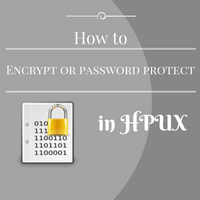Learn how to password protect files in HPUX. This is helpful to encrypt some public readable files using a password and decrypt them whenever needed.

It’s pretty obvious that you can control file access using permissions but sometimes you may want to protect file lying in a public directory like with password of your choice. Or sometimes you may want even root shouldn’t read your files 😉
In that case, you can use crypt command to encrypt your file with a password of your choice. This command is available in HPUX, Solaris. I couldn’t found it in Linux though. crypt command is basically used to encrypt or decrypt files. So basically you will be encrypting your file with the key of your choice and whenever you want to read it back, you need to decrypt it by supplying password/key you chose at the time of encryption.
Locking / encrypting file with key
Let’s take a myfile.txt sample file for encryption. You need to supply this file as an input to crypt command and define the output file (see example below).
# cat myfile.txt
This is test file for crypt.
# crypt < myfile.txt > myfile.crypt
Enter key:
# cat myfile.crypt
3▒▒▒x▒▒X▒n▒d▒6▒▒=▒▒q▒j
Now, crypt command will ask you for a key. Its a password you can set of your choice. Note that, it won’t ask you to retype key. Once executed you can new output file created (with the name given in command). This file is encrypted and can’t be read using cat, more etc commands!
That’s it! your file in encrypted. Now you can safely delete your original file myfile.txt and keep an encrypted copy on the machine.
Unlocking / decrypting file with key
Now, to retrieve file content back i.e. decryption of file you can run the same command. Only input and output file names will be exchanging their positions. Now, the encrypted filename will be your input file and the original filename will be the output file name.
# rm myfile.txt
# crypt < myfile.crypt > myfile.txt
Enter key:
# ll myfile.txt
-rw------- 1 root users 29 Dec 12 11:51 myfile.txt
# cat myfile.txt
This is test file for crypt.
crypt command checks input file and get to know its encrypted one. So it uses key supplied by user to decrypt it into output file specified in command. You get your file back as it was!
Share Your Comments & Feedback: